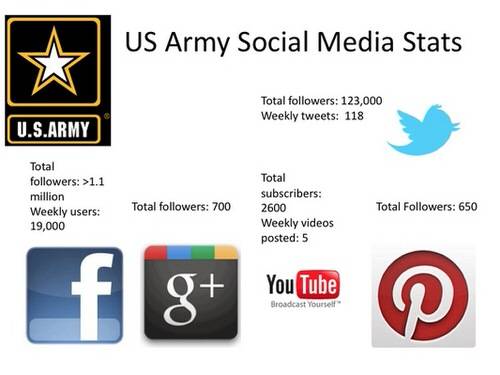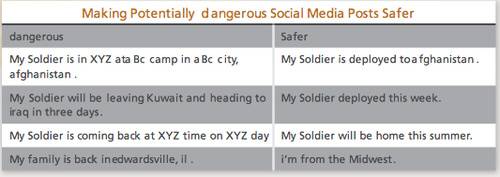Over the past several years, the US Army has developed an exemplary program in exploiting numerous social media methods, and done so without a lot of flash, expense, or personnel. They have an engaged audience, numerous followers, and maintained a multi-pronged campaign into all of the major social media networks, including recent beach-heads in Pinterest and Google+. All this, and with a five-person team based in the Pentagon and without spending much in the way of budget too. They are a worthy case study for organizations that are trying to make their own assaults on social media and haven’t been as effective.

Just look at this slide showing the numbers. Granted, with a potential audience of millions, it shouldn’t be all that unusual that they have the number of Facebook and Twitter followers that they do. But the number of engaged users is what is interesting here.


Let’s take a tour of the Army social media landscape and show you what they are doing right. Regardless of your politics, I think you will agree that they are leading by example when it comes to social media.
- They are a content machine. Each week they coordinate the posts on their various social media properties and there is plenty of fresh content. Any social media strategy needs to be based on terrific content, and regular infusions of it. They have this one covered, in spades. Just look at the two dozen pinboards they have already created on Pinterest, where our soldier on a camo couch lead image was taken from (you didn’t see him at first, admit it).
- Leadership is essential. The Army’s efforts are led by Major Juanita Chang who is the Director, Online and Social Media Division for the past two years in the Army’s Office of the Chief of Public Affairs. Chang is a career soldier who has been in active duty since 1996 and served at one point as a chemical weapons officer before she got into PR. Having someone who came up through the ranks is key, because they can emphasize with the boots on the ground and know the entire Army ecosystem too. When you pick your social media team leader, keep this in mind.
- They have solid guidelines for usage. The Army has a 50-page social media manual (which incidentally is a Slideshare link, kudos for that) that walks everyone through what is and isn’t appropriate for posting to particular sites. There are guidelines specific to security, including turning off the GPS or geotagging features of your smartphone and cameras, asking the soldier what could the wrong person do with the information that is posted online, and recommending that photos don’t reveal sensitive information. Also, a soldier should talk to their family members about operational security and be sure everyone knows what can and can’t be posted. Here is just a snippet from their manual:

- They aren’t heavy-handed about it either. The guidelines are all common sense and not what you would expect from an organization that believes in the chain of command. “If we can trust our soldiers with guns and grenades, why can’t we trust them with Facebook?” Major Chang asks. That doesn’t mean they are completely hands-off. A Twitter post from a random civilian that wanted to make note of the recent Medal of Honor winner Salvatore Giunta, was unauthorized, and the Army asked that the relationship be clarified.
- Despite such a broad footprint, they pick their targets and have solid engagement goals. Just like you might expect from them. “We don’t have to be everywhere all the time. We have our goals and want to pick and choose our platforms to establish our presence,” Major Chang told me.
- Humor counts, too. Again, somewhat unexpectedly, the Army has a great sense of humor, at least how it is displayed across its social media empire. Humor is a very important engagement mechanism and a great way to break the social media ice for social media noobs. Take a look at the photo that topped last week’s list of most frequently-shared pics from their Facebook site:

This was shared more than 375 times and Liked by more than 2,000 Facebook users. Granted, pet pics do well but still. Of course, it helps to have more than a million Facebook followers too.
- Know your audience. “We know the audience that we want to reach,” says Major Chang. “We want to connect America with its army. People don’t always know what we do for the everyday Joe Taxpayer in Idaho.” Look at this post on Google+ about a new Army concept vehicle at the Chicago Auto Show. This exposes their comment stream to non-Army Internet users and potentially widens their reach.
- Blogs matter and could be the center that holds everything together. I know in our rush to embrace all that is new we tend to forget about the old, but blogging is still important and can cement the other social media pieces. The Army has one blog destination: the ArmyLive blog which has stories about its soldiers, methods, and values. Six stories were posted in Februrary, making it a vibrant and active place to come read about its doings. Can you say the same thing about your bloggers? And it isn’t all cheerleading either: an article by the Sergeant Major of the Army, Raymond F. Chandler on new uniforms is enlightening. These and other blogs complement its main corporate website.
- Be cost-conscious and leverage free resources. Unlike those stories of thousand-dollar toilet seats and other cost overruns, when it comes to social media the Army is very thrifty. Major Chang was proud that what she has accomplished has been on the cheap: she hasn’t paid for any ad campaigns and mostly relied on word-of-mouth to grow her various properties. “Experts are doing it all for less money. We use the free versions of every platform and do everything in house,” she says. For example, there is the Army’s YouTube channel here that has more than 2600 subscribers and posted five new videos last week (see content point above). Yes, they could have set up an extensive and expensive video streaming site, but why bother when you could it for free?
If you have a captive audience and focus, you can do this too. Remember, the traffic that you quickly gain can quickly leave to other memes-of-the-moment: organic growth is best.










